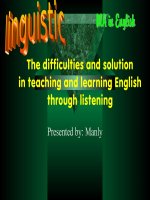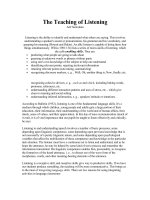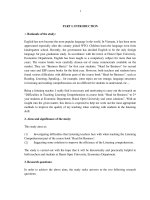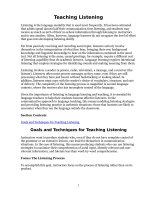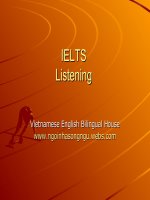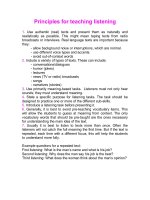Teaching Listening
Bạn đang xem bản rút gọn của tài liệu. Xem và tải ngay bản đầy đủ của tài liệu tại đây (133.27 KB, 12 trang )
Teaching Listening
Listening is the language modality that is used most frequently. It has been estimated
that adults spend almost half their communication time listening, and students may
receive as much as 90% of their in-school information through listening to instructors
and to one another. Often, however, language learners do not recognize the level of effort
that goes into developing listening ability.
Far from passively receiving and recording aural input, listeners actively involve
themselves in the interpretation of what they hear, bringing their own background
knowledge and linguistic knowledge to bear on the information contained in the aural
text. Not all listening is the same; casual greetings, for example, require a different sort
of listening capability than do academic lectures. Language learning requires intentional
listening that employs strategies for identifying sounds and making meaning from them.
Listening involves a sender (a person, radio, television), a message, and a receiver (the
listener). Listeners often must process messages as they come, even if they are still
processing what they have just heard, without backtracking or looking ahead. In
addition, listeners must cope with the sender's choice of vocabulary, structure, and rate
of delivery. The complexity of the listening process is magnified in second language
contexts, where the receiver also has incomplete control of the language.
Given the importance of listening in language learning and teaching, it is essential for
language teachers to help their students become effective listeners. In the
communicative approach to language teaching, this means modeling listening strategies
and providing listening practice in authentic situations: those that learners are likely to
encounter when they use the language outside the classroom.
Section Contents
Goals and Techniques for Teaching Listening
Goals and Techniques for Teaching Listening
Instructors want to produce students who, even if they do not have complete control of
the grammar or an extensive lexicon, can fend for themselves in communication
situations. In the case of listening, this means producing students who can use listening
strategies to maximize their comprehension of aural input, identify relevant and non-
relevant information, and tolerate less than word-by-word comprehension.
Focus: The Listening Process
To accomplish this goal, instructors focus on the process of listening rather than on its
product.
1
• They develop students' awareness of the listening process and listening strategies
by asking students to think and talk about how they listen in their native
language.
• They allow students to practice the full repertoire of listening strategies by using
authentic listening tasks.
• They behave as authentic listeners by responding to student communication as a
listener rather than as a teacher.
• When working with listening tasks in class, they show students the strategies that
will work best for the listening purpose and the type of text. They explain how and
why students should use the strategies.
• They have students practice listening strategies in class and ask them to practice
outside of class in their listening assignments. They encourage students to be
conscious of what they're doing while they complete listening tape assignments.
• They encourage students to evaluate their comprehension and their strategy use
immediately after completing an assignment. They build comprehension checks
into in-class and out-of-class listening assignments, and periodically review how
and when to use particular strategies.
• They encourage the development of listening skills and the use of listening
strategies by using the target language to conduct classroom business: making
announcements, assigning homework, describing the content and format of tests.
• They do not assume that students will transfer strategy use from one task to
another. They explicitly mention how a particular strategy can be used in a
different type of listening task or with another skill.
By raising students' awareness of listening as a skill that requires active engagement, and
by explicitly teaching listening strategies, instructors help their students develop both
the ability and the confidence to handle communication situations they may encounter
beyond the classroom. In this way they give their students the foundation for
communicative competence in the new language.
Integrating Metacognitive Strategies
Before listening: Plan for the listening task
• Set a purpose or decide in advance what to listen for
• Decide if more linguistic or background knowledge is needed
• Determine whether to enter the text from the top down (attend to the overall
meaning) or from the bottom up (focus on the words and phrases)
During and after listening: Monitor comprehension
• Verify predictions and check for inaccurate guesses
• Decide what is and is not important to understand
• Listen/view again to check comprehension
• Ask for help
After listening: Evaluate comprehension and strategy use
2
• Evaluate comprehension in a particular task or area
• Evaluate overall progress in listening and in particular types of listening tasks
• Decide if the strategies used were appropriate for the purpose and for the task
• Modify strategies if necessary
Using Authentic Materials and Situations
Authentic materials and situations prepare students for the types of listening they will
need to do when using the language outside the classroom.
One-Way Communication
Materials:
• Radio and television programs
• Public address announcements (airports, train/bus stations, stores)
• Speeches and lectures
• Telephone customer service recordings
Procedure:
• Help students identify the listening goal: to obtain specific information; to decide
whether to continue listening; to understand most or all of the message
• Help students outline predictable sequences in which information may be
presented: who-what-when-where (news stories); who-flight number-
arriving/departing-gate number (airport announcements); "for [function], press
[number]" (telephone recordings)
• Help students identify key words/phrases to listen for
Two-Way Communication
In authentic two-way communication, the listener focuses on the speaker's meaning
rather than the speaker's language. The focus shifts to language only when meaning is
not clear. Note the difference between the teacher as teacher and the teacher as
authentic listener in the dialogues in the popup screens.
Strategies for Developing Listening Skills
Strategies for Developing Listening Skills
Language learning depends on listening. Listening provides the aural input that serves
as the basis for language acquisition and enables learners to interact in spoken
communication.
Effective language instructors show students how they can adjust their listening
behavior to deal with a variety of situations, types of input, and listening purposes. They
3
help students develop a set of listening strategies and match appropriate strategies to
each listening situation.
Listening Strategies
Listening strategies are techniques or activities that contribute directly to the
comprehension and recall of listening input. Listening strategies can be classified by how
the listener processes the input.
Top-down strategies are listener based; the listener taps into background knowledge of
the topic, the situation or context, the type of text, and the language. This background
knowledge activates a set of expectations that help the listener to interpret what is heard
and anticipate what will come next. Top-down strategies include
• listening for the main idea
• predicting
• drawing inferences
• summarizing
Bottom-up strategies are text based; the listener relies on the language in the message,
that is, the combination of sounds, words, and grammar that creates meaning. Bottom-
up strategies include
• listening for specific details
• recognizing cognates
• recognizing word-order patterns
Strategic listeners also use metacognitive strategies to plan, monitor, and evaluate their
listening.
• They plan by deciding which listening strategies will serve best in a particular
situation.
• They monitor their comprehension and the effectiveness of the selected strategies.
• They evaluate by determining whether they have achieved their listening
comprehension goals and whether the combination of listening strategies selected
was an effective one.
Listening for Meaning
To extract meaning from a listening text, students need to follow four basic steps:
• Figure out the purpose for listening. Activate background knowledge of the topic
in order to predict or anticipate content and identify appropriate listening
strategies.
• Attend to the parts of the listening input that are relevant to the identified
purpose and ignore the rest. This selectivity enables students to focus on specific
items in the input and reduces the amount of information they have to hold in
short-term memory in order to recognize it.
4
• Select top-down and bottom-up strategies that are appropriate to the listening
task and use them flexibly and interactively. Students' comprehension improves
and their confidence increases when they use top-down and bottom-up strategies
simultaneously to construct meaning.
• Check comprehension while listening and when the listening task is over.
Monitoring comprehension helps students detect inconsistencies and
comprehension failures, directing them to use alternate strategies.
Developing Listening Activities
Developing Listening Activities
As you design listening tasks, keep in mind that complete recall of all the information in
an aural text is an unrealistic expectation to which even native speakers are not usually
held. Listening exercises that are meant to train should be success-oriented and build up
students' confidence in their listening ability.
Construct the listening activity around a contextualized task.
Contextualized listening activities approximate real-life tasks and give the listener an
idea of the type of information to expect and what to do with it in advance of the actual
listening. A beginning level task would be locating places on a map (one way) or
exchanging name and address information (two way). At an intermediate level students
could follow directions for assembling something (one way) or work in pairs to create a
story to tell to the rest of the class (two way).
Define the activity's instructional goal and type of response.
Each activity should have as its goal the improvement of one or more specific listening
skills. A listening activity may have more than one goal or outcome, but be careful not to
overburden the attention of beginning or intermediate listeners.
Recognizing the goal(s) of listening comprehension in each listening situation will help
students select appropriate listening strategies.
• Identification: Recognizing or discriminating specific aspects of the message, such
as sounds, categories of words, morphological distinctions
• Orientation: Determining the major facts about a message, such as topic, text
type, setting
• Main idea comprehension: Identifying the higher-order ideas
• Detail comprehension: Identifying supporting details
• Replication: Reproducing the message orally or in writing
Check the level of difficulty of the listening text.
The factors listed below can help you judge the relative ease or difficulty of a listening
text for a particular purpose and a particular group of students.
5
